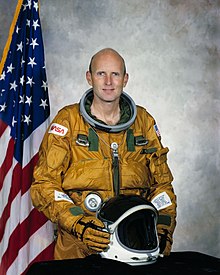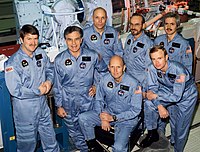C. Gordon Fullerton
Gordon Fullerton | |
|---|---|
 Fullerton in 1979 | |
| Born | Charles Gordon Fullerton October 11, 1936 Rochester, New York,U.S. |
| Died | August 21, 2013(aged 76) |
| Education | California Institute of Technology(BS,MS) |
| Awards | Distinguished Flying Cross NASA Distinguished Service Medal |
| Space career | |
| NASA astronaut | |
| Rank | Colonel,USAF |
Time in space | 15d 22h 50m |
| Selection | USAF MOL Group 2 (1966) NASA Group 7 (1969) |
| Missions | ALT STS-3 STS-51-F |
Mission insignia |    |
| Retirement | December 31, 2007 |
Charles Gordon Fullerton(October 11, 1936 – August 21, 2013) was aUnited States Air Forcecolonel,a USAF andNASAastronaut,and a research pilot at NASA'sDryden Flight Research Facility,Edwards, California.[1]His assignments included a variety of flight research and support activities piloting NASA'sB-52launch aircraft, theBoeing 747Shuttle Carrier Aircraft(SCA), and other multi-engine and high performance aircraft.
Fullerton logged more than 380 hours in space flight, and was a NASA astronaut from September 1969 until November 1986 when he joined the research pilot office at Dryden. In July 1988, he completed a 30-year career with theU.S. Air Forceand retired as a colonel. He continued in his position of NASA research pilot as a civilian. Fullerton, his wife, and their two children lived inLancaster, California.
Biography[edit]
Early years and education[edit]
Born October 11, 1936, inRochester, New York,Fullerton graduated fromUlysses S. Grant High School,Portland, Oregon,in 1953.[2]He receivedBachelor of ScienceandMaster of Sciencedegrees inmechanical engineeringfrom theCalifornia Institute of Technology,Pasadena, California,in 1957 and 1958, respectively.[3]
Air Force career[edit]
Fullerton entered the U.S. Air Force in July 1958 after working as a mechanical design engineer forHughes Aircraft Company,Culver City, California.[3]
After primary and basic flight school, he was trained as anF-86interceptor pilot, and later became aB-47bomber pilot atDavis-Monthan Air Force Base,Arizona.In 1964 he was chosen to attend the Air ForceAerospace Research Pilot School(now the U.S. Air Force Test Pilot School),Edwards Air Force Base,California. Upon graduation he was assigned as a test pilot with the Bomber Operations Division atWright-Patterson Air Force Base,Ohio.In 1966, Fullerton was selected for and served as a flight crew member for the Air ForceManned Orbiting Laboratory(MOL) program until its termination in 1969.[3]
NASA career[edit]
Fullerton was part ofNASA Astronaut Group 7in September 1969 after the cancellation of the MOL program. After assignment to the NASA Johnson Space Center as an astronaut, Fullerton served on the support crews for theApollo 14,15,16,and17lunar missions.[3]
In 1977, Fullerton was assigned to one of the two-man flight crews which piloted the Space Shuttle prototypeEnterpriseduring theApproach and Landing TestsProgram at Dryden that same year.[4]
Fullerton was the pilot on the eight-daySTS-3Space Shuttleorbital flight test mission March 22–30, 1982. Launched from theKennedy Space Center,Florida,the mission exposed the orbiterColumbiato extremes in thermal stress and tested the 50-foot (15 m)Canadarmused to grapple and maneuver payloads to orbit.[3]STS-3 landed atNorthrup Strip,White Sands, New Mexico,becauseRogers Dry Lakeat Edwards AFB was wet due to heavy seasonal rains.[3]
Fullerton was commander of theSTS-51-F"Spacelab 2" mission, launched from Kennedy Space Center on July 29, 1985. This mission, with the orbiterChallenger,was the first pallet-onlySpacelabmission and the first to operate the Spacelab Instrument Pointing System (IPS). It carried 13 major experiments in the fields of astronomy, solar physics, ionospheric science, life science, and a super fluid helium experiment. The mission ended August 6, 1985, with a landing at Edwards Air Force Base.[4]
Research test pilot career[edit]
Fullerton served as project pilot on the NASA/Convair 990aircraft which has been modified as a Landing Systems Research Aircraft to test Space Shuttle landing gear components.[1]Additionally, Fullerton was also project pilot onF-18Systems Research Aircraft, a test bed to develop new flight control actuators, fiber optic control systems, and other advanced aircraft technology.[1]
As the project pilot on thePropulsion Controlled Aircraftprogram, he successfully landed anF-15and anMD-11with all control surfaces fixed, using only engine thrust modulation for control.[1][4]
In addition to these activities, Fullerton was a project pilot on a number of other research programs at Dryden. Among them were theC-140Jetstar Laminar Flow Control,F-111Mission Adaptive Wing,F-14Variable Sweep Flow Transition, Space Shuttle orbiter drag chute and F-111 crew module parachute tests with theB-52,andX-29vortex flow control.[1]As project pilot on the B-52 launch aircraft, Fullerton was involved in tests to develop a new F-111 crew module recovery system. He also flew the B-52 for the first six mid-air launchings of the commercially developedPegasus space vehicle.[5]
Fullerton was one of two NASA pilots who flew the Russian-builtTu-144LLsupersonic aircraft used in a joint high speed research program.[6]
With over 16,000 hours of flying time, Fullerton piloted 135 different types of aircraft, including full qualification in theT-33,T-34,T-37,T-39,F-86,F-101,F-106,F-111, F-14, X-29,KC-135,C-140, and B-47.[3]After joining Dryden as a research pilot, Fullerton piloted nearly all the research and support aircraft flown at the facility, including theT-38,F-18, F-15, B-52, NASA/Convair 990, 747 Shuttle Carrier Aircraft, and theDC-8.[1]
Later years and death[edit]
Fullerton retired in 2007.[2]He suffered astrokein 2009 and was cared for in a facility inLancaster, California,where he died from complications on August 21, 2013, aged 76.[3]
Awards and honors[edit]
Military and government awards[edit]
Other awards and honors[edit]
- Iven C. Kincheloe Awardfrom theSociety of Experimental Test Pilots,1978[4]
- U.S. Astronaut Hall of Fame,2005 inductee[7]
- GeneralThomas D. WhiteSpace Trophy, 1977[8]
- Haley Space Flight Award from theAmerican Institute of Aeronautics and Astronautics[4]
- Golden Plate Award of theAmerican Academy of Achievement,1982[9]
- Certificate of Achievement Award from theSoaring Society of America[4]
- Ray E. Tenhoff Awardfrom theSociety of Experimental Test Pilotsin 1992 and 1993.[4]
- Fellow of theSociety of Experimental Test Pilots[4]
- Member,Tau Beta Pi[4]
- Honorary member of the National World War II Glider Pilot Association[4]
- Fellow of theAmerican Astronautical Society[4]
Fullerton was inducted with Lousma into theInternational Space Hall of Fameduring a ceremony with the governor of New Mexico in 1982 for their involvement in the STS-3 mission.[10]The governor also presented them with the International Space Hall of Fame's Pioneer Award, and were the second group to receive this award.[11]
References[edit]
- ^abcdefNASA biography of Gordon Fullerton,retrieved November 17, 2009
- ^abBailey Jr., Everton (August 22, 2013)."Astronaut, former Portlander, dies at 76".The Oregonian.Portland, Oregon. p. B3.RetrievedAugust 24,2013.
- ^abcdefghRobert Z. Pearlman (2013)."Gordon Fullerton, space shuttle test pilot, dies at 76".collectSPACE.RetrievedAugust 21,2013.
- ^abcdefghijklmnopq"Gordon Fullerton NASA Biography"(PDF).NASA. August 2013.RetrievedJanuary 29,2021.
- ^"Orbital names next space station freighter for late pilot-astronaut".collectSPACE. December 9, 2013.
- ^"Research Pilot C. Gordon Fullerton in Cockpit of TU-144LL SST Flying Laboratory".NASA DFRC. Archived fromthe originalon April 12, 2000.
- ^"Hall of Fame Inducts McCandless, 1st Untethered Astronaut".Los Angeles Times.Los Angeles, California. Associated Press. May 1, 2005. p. 34 – via Newspapers.
- ^"The Gen. Thomas D. White USAF Space Trophy"(PDF).Airforce Magazine: USAF Almanac: Records, Trophies, and Competitions(May ed.). USAF. 1997. p. 156.
- ^"Golden Plate Awardees of the American Academy of Achievement".achievement.org.American Academy of Achievement.
- ^"Far Out Honor".Honolulu Star-Bulletin.Honolulu, Hawaii. Associated Press. May 19, 1982. p. 2 – via Newspapers.
- ^"Astronauts to be Inducted into the Space Hall of Fame".Carlsbad Current-Argus.Carlsbad, New Mexico. Associated Press. March 26, 1982. p. 3 – via Newspapers.
Sources[edit]
- 1936 births
- 2013 deaths
- Military personnel from Rochester, New York
- Military personnel from Portland, Oregon
- United States Air Force officers
- Recipients of the Distinguished Flying Cross (United States)
- Recipients of the Defense Distinguished Service Medal
- California Institute of Technology alumni
- United States Astronaut Hall of Fame inductees
- U.S. Air Force Test Pilot School alumni
- American test pilots
- Grant High School (Portland, Oregon) alumni
- United States Air Force astronauts
- Space Shuttle program astronauts
- Burials at Arlington National Cemetery
- Recipients of the NASA Distinguished Service Medal



